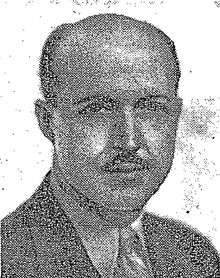Clyde E. Elliott
Clyde Ernest Elliott (born July 23, 1885, Ord, Nebraska; died June 12, 1959 (age 73), Los Angeles, California) was a motion picture director, producer, and writer. He is best known for animal films, especially Frank Buck’s first movie, Bring 'Em Back Alive (1932).[1]
Clyde E. Elliott | |
|---|---|
 Clyde E. Elliott | |
| Born | July 23, 1885 |
| Died | June 12, 1959 (age 73) Los Angeles, California |
| Occupation | motion picture director, producer, and writer |
| Years active | 1919-1947 |
| Spouse(s) | Marie Elliott |
Education and early career
Elliott was a class of 1909 alumnus of the University of Nebraska,[2] and was a newspaper reporter, advertising solicitor and advertising promotion manager before entering the motion picture Industry.[3] He founded Post Pictures Corporation in 1919, to make nature films distributed by Paramount.
Films
_film_poster.jpg)
In Bring ‘Em Back Alive, unlike in most other jungle pictures of the time, Elliott kept the camera in the background. Neither the camera nor the cameramen are visible in any of thescenes. The result is an infinitely clearer conception of the clashes between tigers, pythons and crocodiles than had been achieved in previous films.[4] The movie was a huge hit, Elliott's (and Frank Buck's) most successful and popular film.
In The Devil Tiger (1934), Elliott allowed his star, Kane Richmond, to fight a 25 foot python. Richmond hated snakes but hated doubles more, and had insisted. The actor, on his feet, on the ground, on his feet again, succeeded in holding the snake's snapping mouth away from his face, while struggling to free himself from the triple coils around his body. At the height of the struggle, the heroine, Marion Burns, runs in and saves the hero from the python. Ms Burns had to fight the snake too, in order to get at Richmond's pistol, with which she was supposed to dispatch the python. She played her own scene, as well.[5]
In 1935, Elliott was scheduled to visit Mongolia for Columbia Pictures to produce a film called China Roars. He was to be accompanied by one author (Gordon Rigby), two camera men (Carl Berger and Robert Miller), one assistant director, a business manager, a sound man (Zultan Kagel) and one American actor, whom Elliott hoped would be "a cross between Clark Gable and Ronald Colman." The story concerned an American physician and his Chinese aviator friend who decided to fly over the route to India once followed by Marco Polo. They are forced down in the Gobi Desert, taken prisoner by a nomad tribe, finally escape and, after a series of adventures which include a fight with river pirates, return to Shanghai. This movie was never made.[6]
In Booloo (1938) Elliott produced and directed the story of Captain Robert Rogers (Colin Tapley), who organizes a search for a white tiger in the Malayan jungle to clear his father's name.
Elliott was a director (uncredited) of the Frank Buck film Jacaré. To Elliott's great relief, Jacaré was not "doctored" with scenes made at the studio of white girls lost in the jungle, a process, he claimed, by which Paramount had ruined Booloo.[7]
Elliott's last film, Little Trunk (1947), was to have been set partly in Singapore. It was to show the reunion of a planter and his wife a few months after the end of World War II. It then was to quickly move 300 miles north to their rubber estate, on and near which the main action was to unfold. The plot revolved around incidents in the struggle of the couple to restore their war-wrecked plantation to productivity in the face of discouraging odds created by intriguing natives, wild animals and nature's angry moods. This film was never completed.[8]
From 1945–1950, Elliott was editor of the Santa Ana Independent, a weekly newspaper published from 1935–1966.
References
_film_crew.jpg)
- Clyde Elliott, 74 (sic); made jungle films. New York Times. June 14, 1959 p 86
- Nebraska alumni to dine. First annual affair here to be held on charter anniversary. New York Times. Feb 14, 1926 p E3
- International Motion Picture Almanac, 1948 - Page 94
- Mordaunt Hall. Frank Buck's Exciting Adventures in Trapping Jungle Beasts. New York Times. Jun 18, 1932 p 9.
- James O. Spearing. The Difficulty in Finding an Actor Willing to Wage a Battle With a Python. New York Times. Feb 12, 1933, p 141.
- Frank Nugent. Toward Mongolia turns a roving film maker. New York Times, January 27, 1935
- Thomas F. Brady. Hollywood’s story marts dry up. New York Times. May 24, 1942 p X3
- Clyde E. Elliott. Past Failures and Future Possibilities of Once Popular Animal Films Are Examined by a Veteran Director. New York Times. Nov 2, 1947, p X5.
Bibliography
- Lehrer, Steven (2006). Bring 'Em Back Alive: The Best of Frank Buck. Texas Tech University press. p. 248. ISBN 0-89672-582-0.
Filmography
- The Lone Indian (1921)
- Trees, a Noble Folk (1921)
- My Barefoot Boy (1921)
- A Bit Old Fashioned (1921)
- Le voyageur (1921)
- The City (1921)
- A Winter's Tale (1922)
- Western Ways (1922)
- Bring 'Em Back Alive (1932)
- The Devil Tiger (1934)
- Booloo (1938)
- Jacare (uncredited, 1942)
- Citizen Saint (1947)
External links
| Wikimedia Commons has media related to Clyde E. Elliott. |